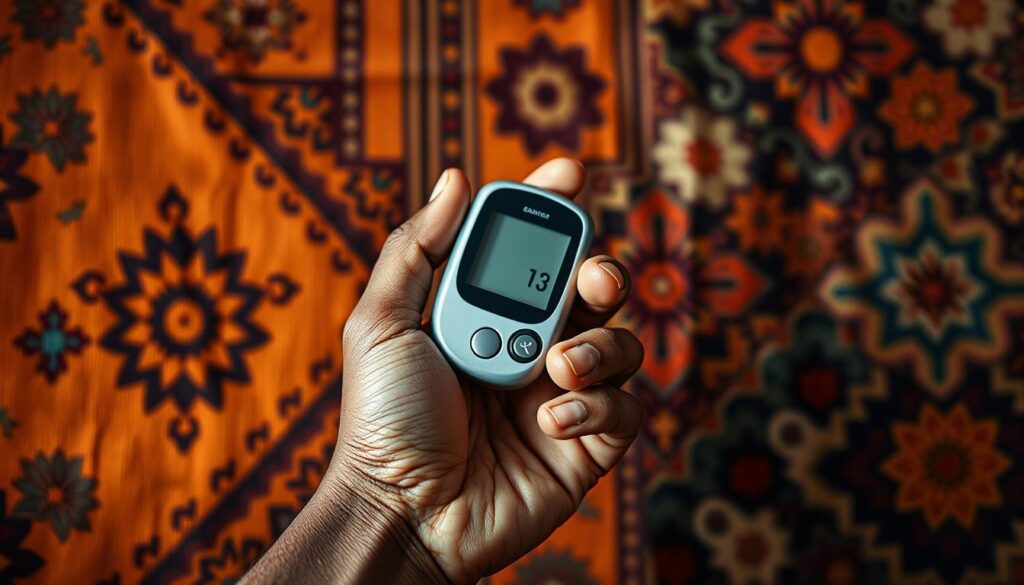In Sudan, over 12% of adults have Type 2 diabetes. This is much higher than the global average. It makes us wonder about the role of Sudanese sugar in their diet. Sudanese sugar is used in many traditional dishes. It has more fructose than regular sugar. This could make blood sugar levels rise faster, increasing the risk of Type 2 diabetes.
Understanding Sudanese Sugar and Diabetes Type 2
Sudanese sugar is a traditional sweetener with a special place in diabetes talks. It’s made from sugarcane grown in Sudan’s rich lands. Its making process is different from regular sugars, which might change how it affects blood sugar.
What Is Sudanese Sugar?
Sudanese sugar has a unique taste and texture because it keeps natural molasses. Unlike refined sugars, it has some nutrients. But, it’s sugar content can raise blood sugar levels. Studies say its sugar makeup is like other cane sugars, but how people in Sudan eat it shows different health effects.
The Science Behind Sugar and Blood Glucose
Sugars turn into glucose when we eat them. Our body uses insulin to keep blood glucose in check. Too much sugar, from foods with a high glycemic index, can overwork insulin production. Research shows that how much sugar leads to type 2 diabetes varies by person. But, eating too much sugar often increases the risk. Things like fiber and how fast sugar is absorbed also play a role.

The Sudanese Blood Glucose Connection
Studies have found links between sudanese sugar effects on diabetes in people who eat it a lot. Unrefined sugars like Sudanese might be absorbed slower because of their fiber. But, it’s all about how much and how often you eat it. Old recipes use less sugar than today’s diets, which are linked to more diabetes. Scientists are looking into these patterns to find the sudanese blood glucose secret.
The Health Impact of Sudanese Sugar Consumption
Too much of this sweetener can lead to a higher risk of Type 2 diabetes. It can mess with blood sugar levels, making the body work harder to keep insulin levels right.

Sudanese sugar’s high glycemic index can make inflammation and obesity worse. These are risks for heart disease and other serious health problems.
- High sugar diets increase insulin resistance, a precursor to diabetes.
- Traditional Sudanese recipes often use sugar in staple foods, raising daily intake levels.
- Early intervention can reduce sudanese sugar diabetes risk through diet adjustments.
New studies show how genetics and diet affect Sudanese people. Even a little sugar can be risky because of how they usually eat.
How Sudanese Sugar Affects Insulin Resistance?
Insulin resistance is key in type 2 diabetes. Sudanese sugar’s effect on this is complex and needs to be studied more.

Signs of Insulin Resistance
Early signs include constant hunger, unexpected weight gain, and slow-healing wounds. Feeling tired or sleepy after eating—does too much sugar make a diabetic sleepy—is a warning sign. High blood sugar after eating sudanese sugar can make these symptoms worse for diabetics.
How Sugar Types Alter Insulin Function?
Not all sugars impact insulin the same. Refined sugars cause quick insulin spikes, while complex carbs absorb slowly. Sudanese sugar, with more fructose, can lower insulin sensitivity over time. This can lead to long-term high blood sugar, which strains insulin-making cells.
Why Sudanese Sugar Differs from Other Sweeteners?
Sudanese sugar keeps natural molasses, changing how it affects blood sugar compared to white sugar. These compounds might slow insulin release but cause it to clear slowly from the body. Research shows it can raise the risk of insulin resistance more than refined sugars.
Effective Strategies to Control Blood Sugar While Consuming Sudanese Sugar
Managing diabetes with Sudanese sugar is all about balance. Small changes can lead to big improvements. Start by controlling portions: use a teaspoon or kitchen scale to measure. Keep track of how much you eat each day to avoid too much.
Portion Control Techniques
- Use 1 tsp of Sudanese sugar per serving
- Log consumption in a food diary
- Compare portions to everyday objects (e.g., ¼ tsp = a pea-sized amount)
Dietary Modifications
Pair Sudanese sugar with foods high in fiber like oatmeal or lentils. Add protein sources like nuts or chicken to slow down how your body absorbs sugar. Spread out carbs across meals to keep your blood sugar steady.
Exercise Recommendations
- Walk briskly for 15-30 minutes after meals
- Incorporate resistance training 3x weekly to boost insulin sensitivity
- Choose high-intensity interval training (HIIT) for faster glucose metabolism
Alternative Sweeteners
For diabetes type 2 prevention, try low-glycemic sweeteners. Stevia and erythritol have little effect on blood sugar. Always check labels for added sugars. Use glycemic index charts to find the best sugar for type 2 diabetes.
Common Misconceptions About Sudanese Sugar and Type 2 Diabetes
It’s important to know the truth about sudanese sugar diet and diabetes. Many false beliefs about sugar and health are out there.
- Myth: Sudanese sugar is “natural” and safe. All sugars, including traditional ones, raise blood sugar levels the same way. Being natural doesn’t mean it’s good for your blood sugar.
- Myth: Sudan is the country where type 2 diabetes is most common. But, countries like Saudi Arabia and the UAE actually have higher rates. This is because of their diets and lack of exercise, not just Sudanese sugar.
- Myth: sugar indications directly cause diabetes symptoms. Signs like tiredness or needing to pee a lot mean diabetes is getting worse. Sugar itself doesn’t cause these symptoms. Its impact is felt over time through how it affects your body.
Taking Control of Your Health Beyond Sugar Choices
Managing sugar intake and preventing type 2 diabetes is more than just avoiding sweeteners like Sudanese sugar. It’s about changing daily habits, dealing with environmental factors, and understanding cultural practices. Regular exercise, even short walks, helps cells use insulin better, lowering diabetes risks.
Getting enough sleep and managing stress are also key to keeping blood sugar levels stable. Try to sleep 7–9 hours each night and use mindfulness to lower stress hormones. These actions help your metabolism, just like following dietary advice from the CDC.
It’s important to keep an eye on your health. Check your HbA1c levels and talk to your doctor about how to balance your diet with your cultural traditions. Making small changes, like using monk fruit or stevia instead of Sudanese sugar, can help keep your cultural heritage while improving your health.
